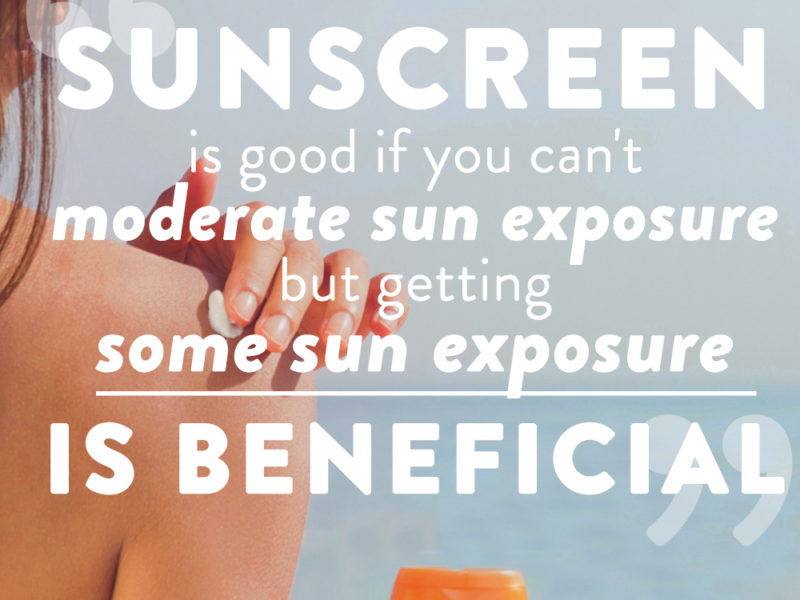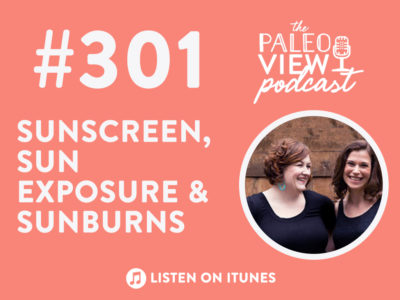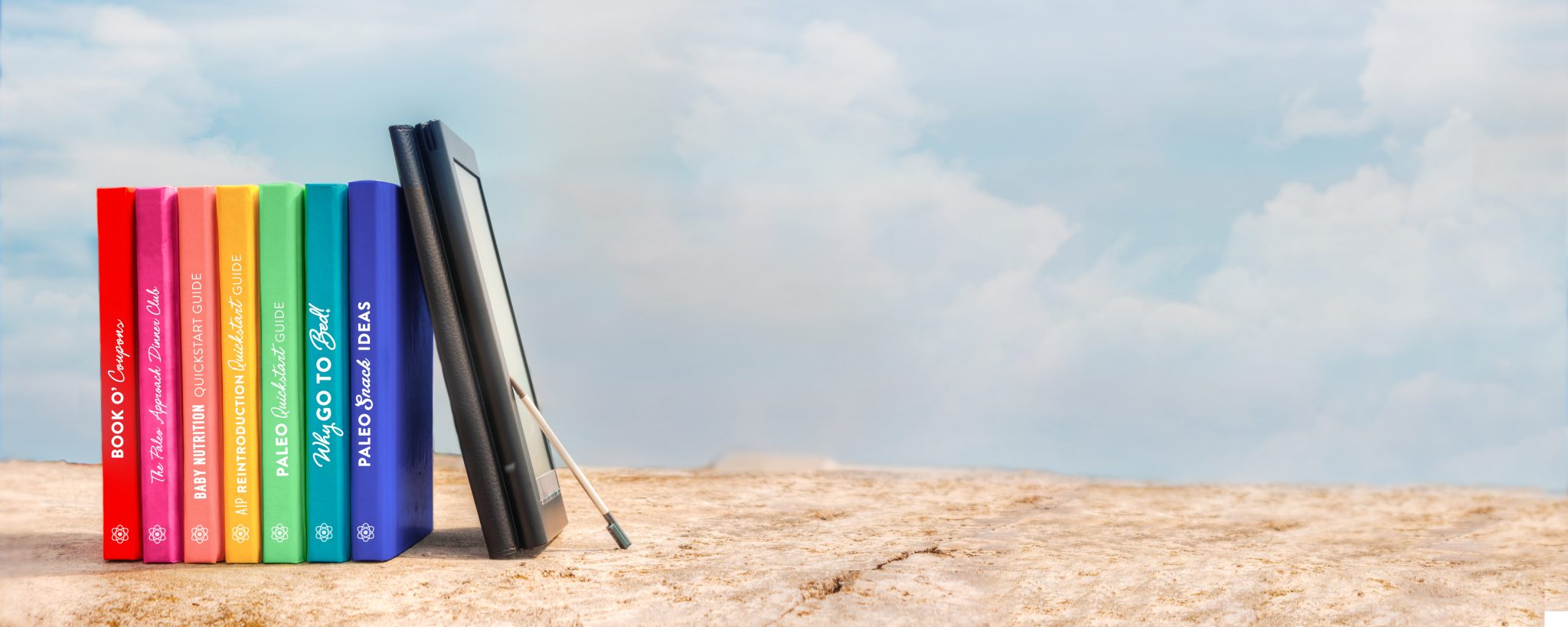In this episode, Stacy and Sarah are talking all about sunscreen, sun exposure & sunburns.
Click here to listen in iTunes
or download and listen by clicking the PodBean Player below
![]()
If you enjoy the show, please review it on iTunes!
The Paleo View (TPV), Episode 301: Sunscreen, Sun Exposure & Sunburns
- Intro (0:00)
- News and Views (0:40)
- This week’s podcast breaks the record for most research done on a topic for a podcast!
- We’re hoping to give you well-rounded, consensus, and nuanced information.
- There is a lot of science on this information, and it doesn’t always agree.
- Shoutout to our listeners for sending wonderful supportive feedback after we asked last week!
- Sun & Skin (12:25)
- The background: Stacy’s family is very fair-skinned, and she is very aggressive with sunscreen use. She has looked into the safety of sunscreen- what kind of sun is good and not good, plus not adding harmful chemicals to our bodies.
- What are risk factors for skin cancer?
- This is the dominant motivator for wanting to protect our skin.
- Sun exposure is a risk for skin cancer but is different for different forms of skin cancer.
- Melanoma: most dangerous, highest mortality rate.
- More related to sporadic intense exposure to burns.
- Interestingly, people tend to get this on parts of the body not most-exposed to the sun.
- This probably indicated that contributing factors are more complex.
- Basal and Squamous Cell Carcinoma are much milder and typically easier to treat.
- The highest risk is total UV exposure, cumulative to date.
- The more sun exposure, especially burning, the higher your chance.
- Melanoma: most dangerous, highest mortality rate.
- There are other risk factors for skin cancers (and other cancers) as well:
- Vitamin D deficiency.
- Exposure to chemicals.
- Having a weakened immune system.
- Smoking.
- Family history.
- Fair complexion or being a red-headed.
- Having moles increases the risk of Melanoma.
- Men are at higher risk of skin cancer than women.
- Is it true that childhood sunburns increase your risk of skin cancer later on in life?
- One study showed that overall there was no increased risk for melanoma.
- There was a slightly increased risk for melanoma in your 20s, but not overall in life.
- There is a group of studies showing that sun exposure is a risk factor for skin cancer.
- It is likely a collection of factors.
- For example, sun exposure in the context of not getting enough antioxidants in the diet.
- In the context of increased inflammation from chronic disease.
- In the context of vitamin D deficiency.
- In the context of more chemical exposure.
- It is likely a collection of factors.
- Sun Tan vs. Sun Burn
- These are two different things, caused by two different mechanisms.
- A suntan is caused by melanocytes in the skin producing melanin (a dark pigment).
- Having a lot of melanin in your skin protects from damage from the sun.
- This is why people with darker complexions have a lower risk of skin cancer.
- Burning is really just cellular damage.
- When you have a lot of cells dying from sun exposure, it triggers an inflammation response- which is what causes the heat/inflammation and makes the skin so red.
- How intense the sunlight is, and how long you were out in it versus how fair you are is the formula for a sunburn.
- These are two different things, caused by two different mechanisms.
- Sunscreen use related to skin cancer risk.
- Prior to 1980, this was true, which is probably because there were a lot of chemicals used in sunscreen that has since been removed.
- These chemicals were inert by themselves, but when exposed to the sun turned carcinogenic.
- Currently, no form of skin cancer is associated with sunscreen use.
- There is a collection of studies that looked at prevention of skin cancer with sunscreen use.
- These studies didn’t show a strong effect.
- This may be because people are using sunscreens to stay out in the sun longer.
- It may have to do with the type of sunscreen they are using.
- These studies didn’t show a strong effect.
- Prior to 1980, this was true, which is probably because there were a lot of chemicals used in sunscreen that has since been removed.
- Benefits of non-burning sun exposure.
- Could people be going so overboard with sunscreen use that they are missing out on some of the benefits of sun non-burning exposure?
- Vitamin D deficiency: 75% of Westerners are vitamin D deficient.
- Stress relieving and circadian rhythm benefit to being out in the sun.
- A recent article compared life expectancy of people with different sun exposure times.
- High sun people did have an increased risk of skin cancer but lower risk of other health problems.
- There may be benefits of sun exposure that we don’t completely understand.
- Could people be going so overboard with sunscreen use that they are missing out on some of the benefits of sun non-burning exposure?
- Overview of sun exposure.
- It is important to not get sunburned, as this increases the risk of skin cancer.
- It is better to use a sunscreen and still get sun exposure if you would otherwise burn.
- Moderating sun exposure is important- some sun exposure is beneficial.
- Is an anti-inflammatory, nutrient-dense diet related to reduced sunburn?
- Our skin has natural antioxidants and protective mechanisms.
- It is chronically being assaulted by everything in the environment.
- It is constantly regenerating to maintain a barrier between the inside and outside of our bodies.
- A higher plant phytochemical diet can reduce the chance of getting sunburned.
- Astaxanthin is one of the stronger antioxidants that helps with this.
- This is in red and purple type vegetables.
- It is also found in seafood.
- Astaxanthin is one of the stronger antioxidants that helps with this.
- There are photolyase enzymes in our skin that exist to repair DNA damage.
- These are activated by visible light, and different ones are activated by different wavelengths.
- Our bodies are amazing and they do have ways of repairing and protecting ourselves from sun damage.
- Our skin has natural antioxidants and protective mechanisms.
- Sunscreen and what to look for.
- We will get into this in greater detail next week, though we don’t want to leave you hanging right now!
- There are two different types: chemical and physical.
- Physical sunscreens are mineral based and reflect UV radiation.
- Chemical sunscreens work by absorbing radiation and dissipating it as heat.
- These are a class of chemicals that have high skin irritant and allergic reaction rates.
- Many of these chemicals have been identified as endocrine disruptors.
- Many of these chemicals have been associated with damaging the coral reef.
- Hawaii recently banned chemical sunscreens for this reason.
- We look forward to continuing this conversation next week, as well as the science of the different types of sunscreens!
- Sarah personally looks for a mineral sunscreen that is non-nano and non-aerosol.
- Stacy uses Beautycounter, but there are a lot of great safer options available now.
- If you’ve enjoyed the show, please recommend it to someone who might enjoy it.
- We love when you share and when you leave reviews for us! Thanks for listening!





 Development of Immune Intolerance in Children
Development of Immune Intolerance in Children